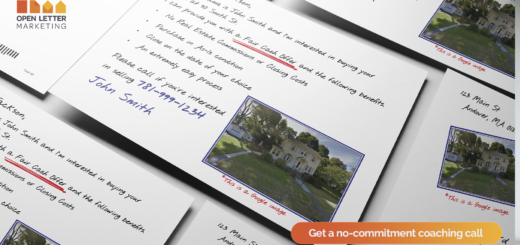How to Create a Successful Real Estate Direct Mail Campaign
Direct mail remains one of the most effective ways for real estate investors to connect with motivated sellers and property owners. Unlike digital ads that vanish after a scroll, physical mailers create a tangible impression and can generate leads, build trust, and position you as the local buyer homeowners turn to.
But sending out postcards or letters alone won’t guarantee results. A successful real estate direct mail campaign requires strategy, consistency, and a clear plan. Here’s a detailed guide to creating direct mail that actually drives deals for investors.
Define Your Goals and Objectives
Every campaign should begin with a clear goal. As an investor, are you trying to:
- Generate leads from absentee or out-of-state owners?
- Reach distressed property owners who may be motivated to sell?
- Build a pipeline of sellers in specific neighborhoods?
- Establish yourself as a trusted local buyer in competitive markets?
Your goal determines the type of mailer, the message, and the call-to-action. For example, a campaign targeting absentee landlords might highlight relief from management headaches, while a campaign to distressed owners could emphasize fast, hassle-free closings.
Pro Tip: Always ask yourself: “What action do I want the seller to take after reading this mailer?” That answer should drive your message and design.
Know Your Audience
Not every homeowner or property owner has the same motivation to sell, and treating them all the same wastes money. Segmenting your list allows you to deliver the right message to the right people.
Consider segmenting by:
- Absentee Owners: Pitch stress-free selling without the burden of long-distance management.
- Distressed Owners: Highlight quick closings, cash offers, and no repairs needed.
- Inherited Properties: Position yourself as the hassle-free solution for estates and probate.
- Tired Landlords: Emphasize relief from tenants, maintenance, and turnover.
By tailoring your message, you speak directly to the pain points that matter most. For instance, an absentee owner doesn’t need to hear about market appreciation; they want convenience and simplicity.
Craft Compelling Content
The message inside your mailer determines whether it goes in the trash or drives a phone call. Content should grab attention, speak to the seller’s needs, and make the next step simple.
Key elements to include:
- Personalization: Reference the property or neighborhood whenever possible.
- Value Proposition: Highlight your benefit as an investor – fast closings, no fees, no repairs.
- Clear CTA: Provide a direct next step, such as calling, scanning a QR code, or visiting a landing page.
- Credibility: Include a line about past purchases or testimonials to build trust.
Your content should strike a balance: empathetic but professional, persuasive without being pushy. Sellers need to feel you are a real solution, not just another generic postcard.
Design Matters
Even the strongest message can get lost in poor design. A cluttered, text-heavy mailer gets ignored, while clean and clear layouts make sellers pause.
Tips for investor mailer design:
- Keep layouts simple with plenty of white space.
- Use bold headlines that highlight the benefit (“Sell Fast. No Repairs. No Fees.”).
- Choose professional envelopes and letterheads that build credibility.
- Make your call-to-action highly visible.
Remember: Many homeowners will only skim. Make sure the most important message (your offer and CTA) jumps off the page.
Choose the Right Format
Different formats work for different stages of your campaign. Investors often use a mix of letters and postcards for the best results.
- Postcards: Great for initial outreach. Simple, visual, and easy to digest.
- Letters: More personal and professional. Ideal for serious follow-ups.
- Newsletters/Informational Pieces: Useful for long-term credibility and trust-building.
A proven approach is to start with a postcard for awareness, follow with a professional letter for credibility, and then send a reminder piece to reinforce your message.
Timing and Frequency
Consistency is the backbone of direct mail. One-and-done campaigns rarely work because sellers may not be ready to act the first time.
- Regular Intervals: Monthly or bi-monthly mailings keep you top-of-mind.
- Market Timing: Increase frequency during peak selling periods like spring and summer.
- Follow-Up: Combine mailers with phone calls, texts, or emails for better results.
Sellers often respond after the 5th, 6th, or even 10th touch, so persistence pays off.
Track, Measure, and Optimize
Sending mail without tracking results is like investing blindly. Every campaign should be measured so you know what’s working.
Ways to track:
- Unique phone numbers tied to specific campaigns.
- QR codes or custom URLs to monitor web responses.
- Separate landing pages for different audience segments.
Reviewing your numbers allows you to double down on what’s performing and cut what’s not, ensuring your budget goes further.
Test and Refine
No campaign is perfect the first time. Testing different messages, formats, and mailing schedules helps you continuously improve.
Consider testing:
- Headline variations (e.g., “We Buy Houses Fast” vs. “No Repairs. No Commissions.”)
- Mail formats (letters vs. postcards).
- Different audience lists (absentee vs. inherited).
Start small, measure results, then scale what works. Over time, you’ll build a system that reliably generates leads and closes deals.
Final Thoughts
For investors, direct mail isn’t just marketing, it’s deal flow. The right campaign builds trust, uncovers motivated sellers, and keeps your pipeline full. By defining clear goals, knowing your audience, crafting the right message, designing clean mailers, and staying consistent, you can create campaigns that deliver real results.
If you’re ready to elevate your direct mail strategy and connect with more motivated sellers, Open Letter Marketing can help you craft campaigns that actually convert.
As a bonus, OLM also offers a free coaching call with a direct mail professional. We’ll help you set up your complete campaign, walk you through best practices, and ensure your outreach is built for results from day one.















